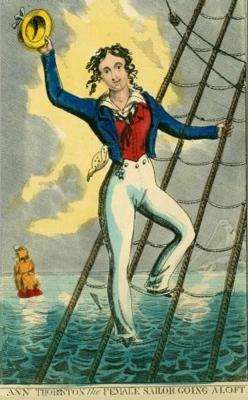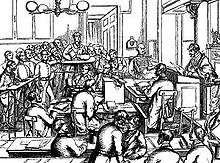Anne Jane Thornton

Anne Jane Thornton (1817–1877), also spelt Ann Jane Thornton, was a 19th-century adventurer from Donegal who in 1832 posed as a boy to go to sea, in pursuit of a lost lover who had gone to the United States. She continued her career as a seaman until her arrival in London in 1835, when she was interviewed by the Lord Mayor of London. She later wrote a book about her adventures.
Early life
Born in Gloucestershire, in the west of England, in 1817, Thornton was the daughter of a prosperous shop-keeper. According to the Oxford Dictionary of National Biography, in 1823 her mother died, and her father moved to Donegal in Ireland where he opened a successful shop.[1] The Lady magazine for 1835 adds a further detail: "...when six years old she accompanied her father to Ireland, where he afterwards possessed profitable stores and subsequently failed".[2]
Life
At the age of thirteen, Thornton met Captain Alexander Burke, an Englishman whose father lived in New York, and before she was fifteen the two had become strongly attached to each other. In 1832, Burke left Donegal to travel to New York, and Thornton made up her mind to go after him. Attended by a maid and a boy, she left Donegal, obtained a suit of cabin boy's clothes, and posing as a boy, made a safe passage to New York.[3] On arrival, she went to Burke's father's house, where she said that she had worked under the captain's orders and wished to be engaged by him again. She learnt from Burke's father that the man she loved had died a few days before.[4]
Without money, Thornton needed to find employment. By now, she had a swarthy complexion, which helped to make her look less like a young woman, and still posing as a boy she got a position at nine dollars a month as ship's cook and steward on board The Adelaide.[1] After this, she had a berth in The Rover.[3] She later served on the Belfast, "dressed in a red worsted Jacket and duck trousers".[5] Between ships, she once walked seventy miles from Eastport, Maine, to St Andrew's, dressed as a sailor.[3][4]
Eventually, Thornton took a position as a ship's cook on another ship, The Sarah, bound for London, giving her name as Jim Thornton from Donegal. As Jim, she proved a great asset to the ship, cooking and also helping out on deck when needed, as the ship was sailing with an under-strength crew.[6]
It was on this vessel that Thornton was discovered as a woman:
One day as she was washing in her berth, with her jacket loose in the front, one of the crew caught an accidental view of her bosom.[7]

The sailor who discovered Thornton threatened that unless she agreed to sexual intercourse with him, he would report her to the ship's master, Captain McIntyre. Thornton refused, and when she was revealed to the master he "turned her out to work amongst the men, by whom she upon all occasions was most grossly insulted".[1][7]
McIntyre recorded his astonishment on learning that Thornton was a woman:
I could scarcely credit the mate when he told me of it. I can bear testimony to the extraordinary propriety of her conduct and I ask again whether I have not acted properly towards her.[8]
The Sarah was bound at the time for London, where she docked in February 1835. Before this arrival, other crew members had suspicions about Thornton's identity, and McIntyre later told The Times that she had been abused by the other sailors and that she had worked hard aboard the ship.[1] McIntyre reported that Thornton
...did the duty of a seaman without a murmur and had infinitely a better use of her hands than her tongue... She performed to admiration. She would run up the top gallant-sail in any sort of weather and we had a severe passage. Poor girl, she had a hard time of it, she suffered greatly from the wet but she bore it all excellently and was a capital seaman.[8]
The story was reported in the London newspapers after a customs officer on the River Thames had intervened to stop a member of The Sarah's crew from mistreating a young sailor, finding to his amazement that the sailor was a young woman. The customs man then lodged Thornton at the Cooper's Arms Tavern in Lower Thames Street and reported the case to his superiors.[6]

After the Lord Mayor of London had read the reports, he sent a police inspector to investigate and subsequently held an inquiry at the Mansion House, himself interviewing all parties concerned, including Thornton and McIntyre. The captain said he had had no suspicion when employing Thornton that she was female and insisted that he had every intention of paying her the money she had earned on the voyage. Called on by McIntyre to say whether he had ever been unkind to her, Thornton replied "No, you were always most considerate. But some of the men struck me cruelly when I could not work as hard as they were in the rough weather".[1][6]
The Lord Mayor berated Thornton for running away from her father, while praising her seafaring conduct, and offered her money to help her to return home to her father in Ireland.[1]
The people of London sympathised with Thornton, and she was offered £500 to appear on the stage, but she refused the offer, stating that she wanted only to go home to her father. However, when the Lord Mayor made inquiries in Donegal he found that Thornton's father had himself emigrated to America, although her sister still lived there and was glad to hear news of Anne Jane. The Lord Mayor booked Thornton a seat on the London to Liverpool coach, and she left for Ireland on 2 April 1835. On 13 April, a newspaper in Ballyshannon reported her arrival in Donegal.[6]
A vast crowd collected to see her, but the sailor hurried to the house of her sister, in the back lane... We were fortunate enough to have seen the young woman. She is now quite tired of the sea she says she would not join a ship again for £500 a year as it is the most wretched life imaginable. She says she will never marry.[6]
Thornton's story became even better known after she wrote an autobiographical book, The Interesting Life and Wonderful Adventures of that Extraordinary Woman Anne Jane Thornton, the Female Sailor.[1]
King William IV granted Thornton a pension of £10 a year, while a Mr Andrew Murray gave her the use of a farm near Lough Eske, rent-free.[6]
In February 1836, Thornton married, under unusual circumstances. One day a friend from Ballyshannon went to Donegal to visit her and found her being dragged to a clergyman by a group of men, who intended her to marry one of them. Her friend rescued her and they were married the next day. She gave birth to a son in November 1836.[6]
Thornton lived until 1877.[9]
Ballad of The Female Sailor Bold
Thornton's story inspired the ballad The Female Sailor Bold, also called The Female Sailor.[3][10][11] The following is the text of the ballad, as sold in the United States from c. 1835.[3]
An edited version appears in The Oxford Book of English Traditional Verse (1983).[12]
Good people give attention and listen to my song; Her name was Ann Jane Thornton, as you presently shall hear, She was courted by a captain when not fifteen years of age, She dress'd herself with sailors clothes and was overcome with joy Then to her true loves fathers she hastened with speed, Some thousand miles she was from home from friends far away |
Then she went on board the Adelaide, to cross the troubled wave From St Andrew's in America this fair maid did set sail, With pitch and tar her hands were hard, tho' once like velvet soft 'Twas in the month of February eighteen hundred thirty five, At the Mansion-House she appear'd before the Lord Mayor, It was to seek her lover that sailed across the main, |
Further reading
- 'A female sailor', serialised in two parts in the Weekly Dispatch of 8 and 15 February 1835 ·
- 'A female sailor', in The Times dated 11 February 1835, p. 6
- The Interesting Life and Wonderful Adventures of that Extraordinary Woman Anne Jane Thornton, the Female Sailor; disclosing important secrets, unknown to the public, written by herself (London: 1835)[13]
Notes
- 1 2 3 4 5 6 7 Wheelwright, Julie, 'Thornton, Anne Jane (b. 1817), sailor and cross-dresser' in Oxford Dictionary of National Biography (Oxford University Press, 2004)
- ↑ The Lady's magazine (and museum) for 1835, Improved series, enlarged, p. 160
- 1 2 3 4 5 The Female Sailor, undated broadsheet, reproduced in Creighton, Margaret S., & Lisa Norling, Iron Men, Wooden Women: Gender and Seafaring in the Atlantic World, 1700–1920 (JHU Press, 1996, ISBN 0-8018-5160-2), p. 36
- 1 2 The Annual Register, or, A View of the History, Politics, and Literature for the Year 1835 (London: James Dodsley, 1836) pp 25–27 at books.google.com, accessed 7 February 2008
- ↑ The Interesting Life and Wonderful Adventures of that Extraordinary Woman Anne Jane Thornton, the Female Sailor, quoted in Ewing, Elizabeth, Women in Uniform Through the Centuries (Rowman and Littlefield, 1975) p. 34
- 1 2 3 4 5 6 7 Foster, Allen, The Donegal girl who became a boy sailor at nwipp-newspapers.com/DN, accessed 7 February 2009
- 1 2 Thornton, Anne Jane, Interesting life and wonderful adventures of that extraordinary woman Anne Jane Thornton, the female sailor, disclosing important secrets, unknown to the public, written by herself (1835), chapter 5
- 1 2 'A female sailor', in The Times, 11 February 1835, p. 6
- ↑ Anne Jane Thornton (1817–1877) at npg.org.uk, accessed 7 February 2009
- ↑ The Female Sailor Bold, ballad sheets, Harvard Houghton Library 25242.17 vol. 4 no. 70
- ↑ Dugaw, Diane, Warrior Women and Popular Balladry 1650–1850 (Cambridge University Press, 1989), p. 217 at books.google.com, accessed 7 February 2009
- ↑ Woods, Frederick (ed.), The Oxford Book of English Traditional Verse (Oxford University Press, 1983, ISBN 0-19-214132-5) p. 154
- ↑ Bell, Peter, Regency Women: An Index to Biographies and Memoirs (1991)
External links
- Anne Jane Thornton (1817–1877) at npg.org.uk, web site of the National Portrait Gallery (London)